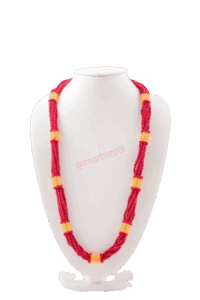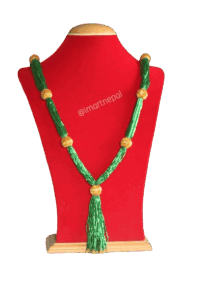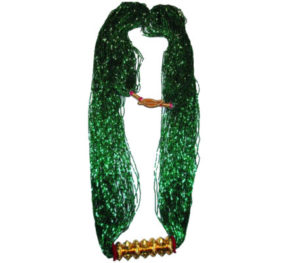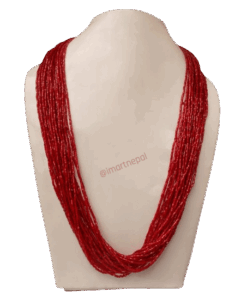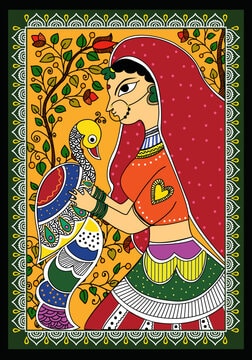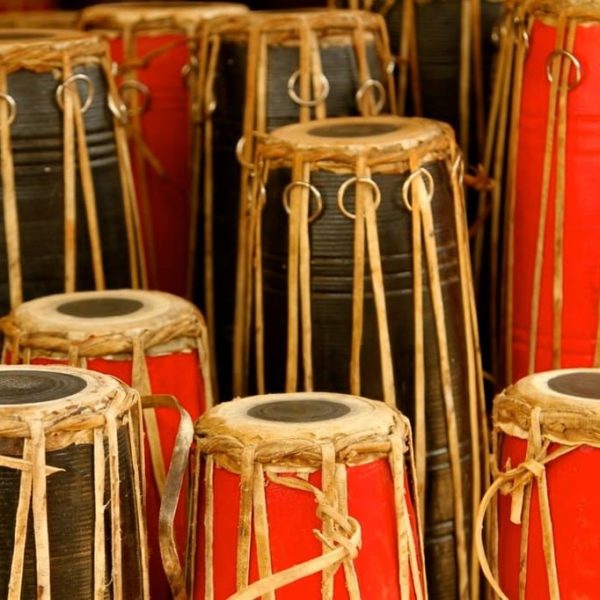INTRODUCTION
In Nepal, cultural heritage is reflected in various forms of attire and adornments, and one such symbolic ornament is the pote—a necklace made of small, vibrant glass beads. Worn predominantly by married women, the pote is not just a piece of jewelry; it is deeply rooted in Nepali customs, representing marriage, femininity, and societal identity. This traditional accessory has evolved over time while maintaining its cultural significance, making it an essential part of Nepali life, especially among women from the Hindu and Newar communities.

HISTORICAL AND CULTURAL SIGNIFICANCE
The pote necklace has a long history in Nepal, particularly among the Hindu population. Traditionally, it signifies the marital status of women and is worn as an auspicious symbol of their husbands’ long life and well-being. Similar to the mangalsutra worn by married women in India, the pote in Nepal represents a woman’s devotion to her spouse, and it is often gifted to a woman at her wedding or during special marital rituals.
In addition to its association with marriage, the pote holds religious significance. The green color, which is most commonly associated with these beads, is believed to represent fertility, life, and renewal. For many Nepali women, wearing pote is an act of reverence toward the goddess Parvati, the Hindu deity of love, fertility, and devotion. By adorning pote, women seek blessings for a prosperous and long-lasting married life.
Among the Newar community, the pote has a more elaborate cultural role, often paired with a golden pendant known as a tilhari. The tilhari, which features prominently in traditional Newar marriages, is worn on top of a long strand of pote beads and is considered a prized possession for married women.

COLORS AND VARIETIES
Although pote is traditionally green, it is now made in a variety of colors, each carrying its own meaning and significance. Red, for instance, is another popular choice for pote, as it symbolizes love, passion, and prosperity in Hindu culture. Married women often alternate between red and green pote necklaces, especially during festivals, rituals, and religious ceremonies.
Today, pote necklaces come in diverse color combinations and patterns, ranging from single strands of beads to multi-strand, elaborate designs. Depending on the occasion, women may choose different styles of pote, with some necklaces designed for everyday wear and others reserved for formal events like weddings and religious gatherings.
The number of strands also varies, from simple single strands for daily use to more elaborate multi-strand necklaces for special occasions. Some pote necklaces feature intricate beading work, incorporating small gold or silver embellishments, while others are adorned with colorful beads that create complex patterns.

TILHARI: A MARRIAGE SYMBOL
As mentioned, in many communities, the pote is paired with a tilhari—a gold cylinder-shaped pendant that hangs from the necklace, especially during weddings or festivals. The tilhari is considered a sacred ornament, with its golden color symbolizing wealth and prosperity. Married women typically wear it as part of their bridal attire or during Teej, a festival celebrated by women for the longevity of their husbands.
The significance of the tilhari combined with pote beads goes beyond its ornamental value. It holds a deep spiritual and cultural connection with the community, signifying not only the marital bond but also the wearer’s participation in age-old rituals and traditions.

MODERN ADAPTIONS AND POPULARITY
While pote has been steeped in tradition, its popularity has only grown over time, and it has now transcended its traditional role. In modern-day Nepal, pote is no longer limited to married women or traditional settings. Many unmarried women and even girls wear pote as a fashion accessory, especially in urban areas where necklaces are viewed as a trendy, culturally-rooted fashion statement. Its vibrant colors and intricate designs have made it a versatile piece of jewelry that complements both traditional and modern outfits.
Jewelry designers and artisans have also embraced the growing demand for pote necklaces by experimenting with new designs, colors, and materials. Today, pote is crafted from glass beads and semi-precious stones, pearls, and metals, making it suitable for a broader range of preferences and budgets. Moreover, pote necklaces have become popular souvenirs among tourists visiting Nepal, who appreciate their cultural significance and aesthetic appeal.
The commercialization of pote has also provided economic opportunities for many women, particularly in rural areas, who craft these necklaces as part of cottage industries. By making and selling pote necklaces, they have been able to achieve a degree of financial independence while keeping the tradition alive.

POTE IN FESTIVALS AND RITUALS
In Nepali culture, festivals are deeply intertwined with religious rituals, and the pote plays an essential role in several of these celebrations. For instance, during the Hindu festival of Teej, married women fast and pray for the well-being of their husbands, and wearing pote along with a tilhari is an important aspect of their attire. The green and red colors of pote are considered particularly auspicious during this time, symbolizing joy, prosperity, and marital harmony.
Similarly, pote is also worn during Dashain, Nepal’s biggest festival, and other important religious and cultural occasions such as weddings, births, and rice-feeding ceremonies (pasni). On such occasions, the necklace serves as more than just a decorative item; it is a sacred piece imbued with cultural and spiritual meaning.

CONCLUSION
The pote necklace is a timeless symbol of tradition, culture, and matrimonial devotion in Nepal. For centuries, this vibrant glass-beaded necklace has been an integral part of a married woman’s identity, representing her marital status, her connection to her husband, and her participation in Nepali customs. While its cultural and religious significance remains intact, pote has also evolved with the times, becoming a versatile fashion statement that transcends age, marital status, and tradition.
Today, the pote serves as a bridge between Nepal’s rich cultural heritage and modern fashion, allowing women to express both their style and their respect for tradition. As it continues to be embraced by new generations and admired worldwide, the pote remains a cherished symbol of Nepali identity.



